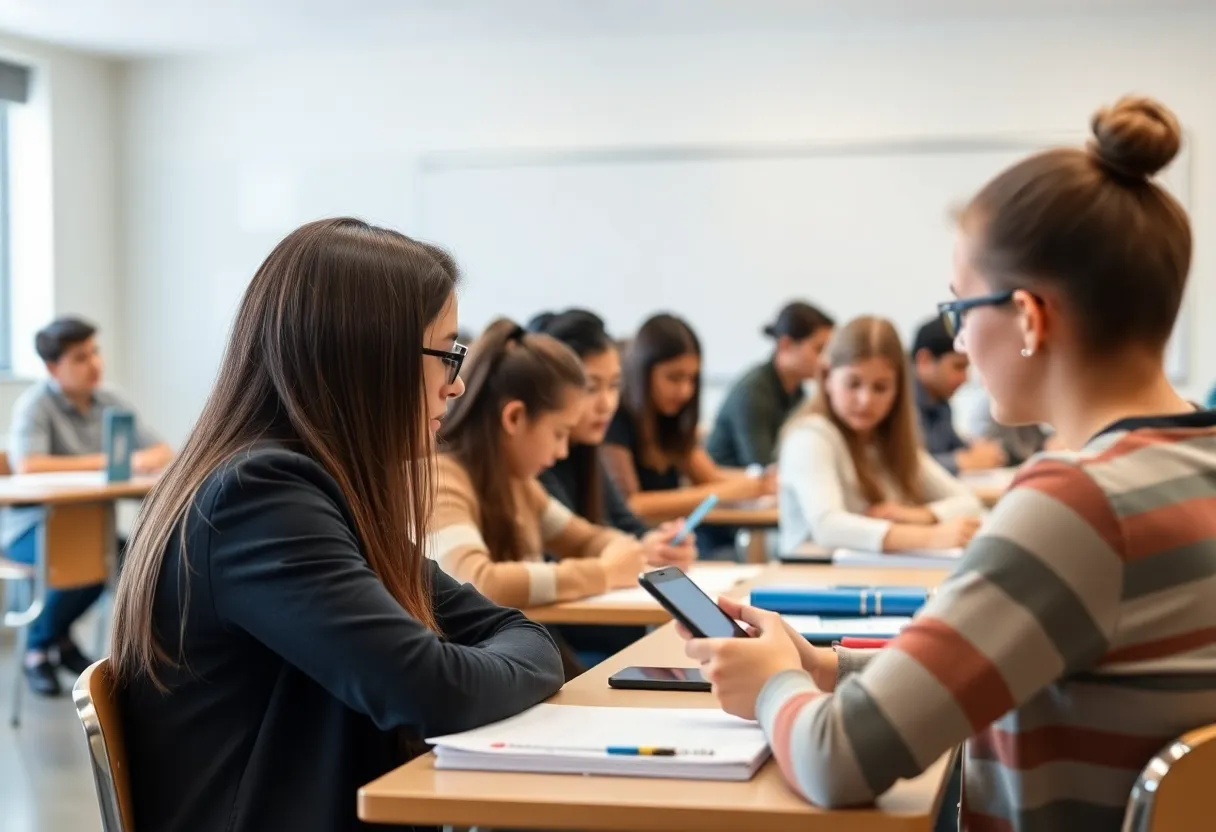Omaha, Nebraska, October 6, 2025
Omaha Public Schools has reported encouraging outcomes from their recent cell phone policy. A district survey indicated a 20% reduction in classroom distractions and fewer bullying incidents in middle and high schools. The policy, enacted to minimize distractions during class hours, has fostered increased student engagement. Although parental responses are mixed, plans for stricter guidelines are on the horizon for future implementation.
Omaha Public Schools Sees Positive Impact from New Cell Phone Restrictions
Omaha, Nebraska – Recent changes to cell phone policies in Omaha Public Schools have shown promising results in just a few weeks. A district-wide survey indicates improved student focus and fewer incidents of bullying in middle and high schools since the restrictions took effect at the start of the semester.
The policy, which prohibits students from using smartphones during class hours, aims to minimize distractions and create a more productive learning environment. Administrators report that the measure has boosted overall student engagement across participating schools. Early data from the survey highlights a 20% drop in classroom distractions, as observed by school principals. This reduction has allowed teachers to maintain better control over lessons and foster deeper interactions with students.
Survey Details and Early Outcomes
The district conducted the survey shortly after implementing the rules, gathering feedback from teachers, students, and staff members. Results show that students are exhibiting higher levels of concentration during instructional time, with fewer interruptions from device notifications or social media use. Bullying incidents, often exacerbated by online interactions, have also decreased noticeably in affected schools.
School leaders attribute these improvements directly to the phone ban. By requiring students to store devices in designated areas or lockers during classes, the policy ensures that attention remains on educational activities. This approach has been particularly effective in middle and high schools, where smartphone use tends to be more prevalent among older students.
Parent Reactions and Concerns
While the district celebrates these initial successes, reactions from parents are not entirely uniform. Some express support for the policy, noting that it helps children develop better habits away from screens and improves their academic performance. Others, however, raise valid concerns about potential emergencies, such as medical issues or family situations that might require immediate access to a phone.
To address these worries, schools have outlined specific protocols for handling urgent matters. Students can access their devices through administrative offices if needed, and parents are encouraged to contact the school directly during school hours. The district emphasizes that safety remains a top priority, and the policy includes provisions to balance restriction with necessary flexibility.
Plans for Expansion and Broader Context
Encouraged by the survey findings, Omaha Public Schools plans to expand the cell phone restrictions next year. This could involve stricter guidelines for elementary schools or adjustments to the current ban based on further data collection. The goal is to standardize the approach across all grade levels, ensuring consistent benefits for student well-being and learning outcomes.
These developments occur amid ongoing national debates on technology in classrooms. Across the country, educators and policymakers grapple with how to integrate digital tools effectively while mitigating their downsides, such as reduced attention spans and cyberbullying. Omaha’s experience provides a local example of one district’s effort to navigate these challenges through targeted restrictions.
The policy’s success in reducing distractions and bullying aligns with similar initiatives in other areas, where limiting phone access has led to measurable gains in student performance. However, the mixed parental feedback underscores the need for ongoing communication and adjustments to meet diverse family needs.
Background on the Policy Implementation
Omaha Public Schools introduced the cell phone restrictions at the beginning of the current semester as part of a broader initiative to enhance the learning environment. The decision followed discussions among district officials about the pervasive role of smartphones in daily student life. Concerns over divided attention, social media pressures, and safety issues prompted the move toward a more controlled approach.
Prior to the ban, classrooms often faced challenges from students checking messages or engaging in non-educational activities on their devices. The new rules require compliance starting from the first bell, with enforcement handled by teachers and support staff. Training sessions for educators preceded the rollout to ensure smooth adoption and consistent application.
As the semester progresses, the district will continue monitoring impacts through additional surveys and performance metrics. This data-driven strategy allows for refinements, ensuring the policy evolves to best serve the community’s students. For now, the positive early results suggest that the restrictions are making a tangible difference in fostering a focused and safer school atmosphere.
In summary, Omaha Public Schools’ cell phone policy has delivered quick wins in student engagement and behavior, though it sparks some debate among stakeholders. With plans for wider implementation, the district positions itself as a contributor to the larger conversation on balancing technology and education.
FAQ
What are the main results from the Omaha Public Schools cell phone restrictions survey?
A district survey shows improved student focus and reduced bullying incidents in middle and high schools.
What does the cell phone policy entail?
The policy bans phones during class hours.
How has the policy affected student engagement?
Administrators credit the policy for boosting engagement, with one principal noting a 20% drop in distractions.
What are parents’ views on the policy?
Parents are mixed, with some praising the change and others concerned about emergencies.
What are the district’s future plans?
The district plans to expand the rules next year amid national debates on tech in classrooms.
Key Features of the Cell Phone Policy Impact
| Feature | Description | Impact |
|---|---|---|
| Policy Scope | Bans phones during class hours in middle and high schools | Reduces distractions by 20% |
| Student Focus | Improved concentration on lessons | Boosts overall engagement |
| Bullying Reduction | Fewer incidents linked to online interactions | Creates safer school environment |
| Parent Feedback | Mixed reactions on emergencies | Protocols in place for urgent access |
| Future Plans | Expansion next year | Addresses national tech debates |
Deeper Dive: News & Info About This Topic
HERE Resources
Omaha Schools Report Positive Outcomes from Phone Restrictions
Omaha-Area Schools Benefit from New Cellphone Restrictions





